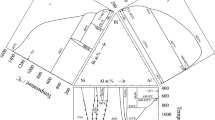Abstract
Experimental studies by electron microprobe analyses, optical microscopy, and differential scanning calorimetry were performed. New data about the liquidus in the central and the Bi-rich regions were obtained. A narrow homogeneity region (about 50–52 at.% Bi) was found for the compound NiBi while the second intermediate phase in this system (NiBi3) was stoichiometric. Thermodynamic optimization of the Ni-Bi phase diagram was achieved by the CALPHAD method by combining phase diagram and thermodynamic data. Thus, NiBi was modeled with two sublattices, allowing mixing of Bi and Ni on one of them only. The intermetallic phase NiBi3 was modeled as a stoichiometric compound. Redlich-Kister polynomials were used to describe the excess Gibbs energies of the solution phases (liquid, pure bismuth, and Ni-based solid solutions).
Similar content being viewed by others
References
M.A. Portevin, The Alloys of Nickel and Bismuth, Rev. Metall., Vol 5, 1908, p 110–20 (in French)
G. Voss, The Nickel-Bismuth System, Z. Anorg. Chem., Vol 57, 1908, p 52–58 (in German)
G. Hägg and G. Funke, X-ray Analysis of the System Ni-Bi, Z. Phys. Chem. B, Vol 6, 1930, p 272–283 (in German)
G.S. Zhdanov, V.P. Glagoleva, N.N. Zhuravlev, and Yu. N. Venevtsev, Structure of Superconductors. I. Investigation of System Bi-Ni. Production and Investigation of Monocrystals Bi3Ni, Zh. Eksp. Teor. Fiz., Vol 25, 1953, p 115–122 (in Russian)
I.I. Kornilov, Nickel and Its Alloys, Academy of Sciences of USSR, Ed. House of the Academy of Sciences of USSR, Moscow, USSR, 1958, p 11 (in Russian)
N. Zhuravlev, G. Zhdanov, and E. Smirnova, Study of Ternary Solid Solutions on the Basis of Superconducting Compounds, Russ. J. Phys. Metall., Vol 13, 1962, p 62–70 (in Russian)
B. Matthias, A. Jayaraman, T. Geballe, K. Andreas, and E. Gorenzwit, Many More Superconducting Bismuth Phases, Phys. Rev. Lett., Vol 17 (No. 12), 1966, p 640–643
R.N. Kuz’min and S.V. Nikitina, Investigation of the Quasi-binary NiBi3-RhBi3 Section of Ni-Bi-Rh System, Izv. Akad. Nauk SSSR, Metally, Vol 4, 1969, p 215–217 (in Russian); Trans.: Russ. Metall., Vol 4, 1969 p 139–141
P. Kumar and Y.N. Sadana. Electrodepositing of Alloys IV. Electrodepositing and X-ray Structure of Bismuth-Nickel Alloys from Aqueous Solutions, J. Less-Comm. Metals, Vol 43, 1975, p 259–265
B.M. Shavinski, P.I. Artyukhin, and Yu. L. Mityakin, Directional Crystallization of Bismuth. III. Determination of the Eutectic Concentration of Some Metals in the Pure Bismuth Region, Izv. Sibir. Otd. Nauk, Vol 5, 1979, p 70–74 (in Russian)
M. Iwase and A. McLean, Activities in Nickel-Bismuth Alloys, Metall. Trans. B, Vol 14B, 1983, p 765–767
H. Fjellvag and S. Furuseth, Structural Properties of Ni1−tRhtBi3, J. Less-Com. Met., Vol 128, 1987, p 177–183
P. Feschotte and J.M. Rosset, Phase Equilibria in the Binary Nickel-Bismuth System, J. Less-Com. Met., Vol 143, 1988, p 31–37 (in French)
A.T. Dinsdale, SGTE Data for Pure Elements, CALPHAD, Vol 15, 1991, p 317–425
Phase Diagrams of Binary Nickel Alloys, P. Nash and A. Nash, Ed., ASM, 1991, p 310
B. Predel, in Landolt-Bornstein, Numerical Data and Functional Relationships in Science and Technology, New Series, O. Madelung, Ed., Group IV: Macroscopic and Technical Properties of Matter, Vol 5, Phase Equilibria, Crystallographic and Thermodynamic Data of Binary Alloys, Subvolume b, B-Ba…C-Zr, Springer-Verlag, Berlin, 1992, p 211–212
T. Massalski, Binary Alloy Phase Diagrams, CD-ROM, ASM International, 1996
A. Kodentsov, G. Bastin, F. Loo, The Diffusion Couple Technique in Phase Diagram Determination, JALCOM, Vol 320, 2001, p 207–217
P.J.T.L. Oberndorff, M.G.A. van Vinken, A.A. Kodentsov, and F.J.J. van Loo, Phase Relations in the Bi-Ni-Pd System at 235 °C, J. Phase Equil., Vol 22 (No. 3), 2001, p 265–268
R. Fratesi, N. Ruffini, M. Malavolta, and T. Bellezze, Contemporary Use of Ni and Bi in Hot-Dip Galvanizing, Surf. Coating Technol., Vol 157, 2002, p 34–39
Pauling File Binaries Edition. Inorganic Materials Database and Design System, CD-ROM, P. Villars, Ed., Japan Science and Technology Corporation (JST) and Material Phases Data System (MPDS), ISBN 3-000-0090436, Germany, 2003.
Author information
Authors and Affiliations
Rights and permissions
About this article
Cite this article
Vassilev, G.P., Liu, X.J. & Ishida, K. Experimental studies and thermodynamic optimization of the Ni-Bi system. J Phs Eqil and Diff 26, 161–168 (2005). https://doi.org/10.1007/s11669-005-0134-0
Received:
Revised:
Issue Date:
DOI: https://doi.org/10.1007/s11669-005-0134-0




